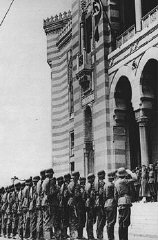| |
CROATIA
In the German puppet state of Croatia (established in April 1941), the Ustasa (Croatian fascists) instituted a reign of terror and systematically killed Serbs, Jews, and Roma (Gypsies). Croatian fascists murdered or expelled hundreds of thousands of Serbs. In the countryside, Ustasa guards burned down entire Serbian villages and killed the inhabitants. Croatian fascists raped Serbian women and tortured Serbian men.
By the end of 1941, about two-thirds of the Jews of Croatia had been imprisoned in camps throughout Croatia (Jadovno, Kruscica, Loborgrad, Djakovo, Tenje, Osijek, and Jasenovac). The Ustasa murdered more than 20,000 Jews in the Jasenovac concentration camp, roughly 60 miles from the Croatian capital of Zagreb. In 1942 and 1943, about 7,000 Jews were deported from Croatia to Auschwitz-Birkenau.
Many Croatian Jews who survived the war sought refuge in the Italian-occupied areas. Rejecting German demands to hand over Jews in these areas, Italian authorities instead assembled many of those in Italian-occupied Yugoslavia in the Rab island camp, which was in the Italian zone. After the Italian government agreed to an armistice with the Allies in September 1943, Germany occupied the Italian zone of Yugoslavia. Yugoslav partisans helped many former prisoners of Rab avoid capture by German forces.
HUNGARIAN- AND BULGARIAN-OCCUPIED YUGOSLAVIA
Initially, Hungary, an ally of Germany, did not deport Jews from territory it occupied in Yugoslavia. But Hungarian army and police units murdered several thousand Jews and Serbs in the Yugoslav city of Novi Sad in January 1942. The deportation of most of the Jews from Hungarian-occupied territory began shortly after the Germans occupied Hungary in March 1944. The Germans concentrated the Jews of the Backa region (formerly part of Yugoslavia) in three camps--Backa-Topolya, Baja, and Bacsalmas--from which they were deported to Auschwitz. Most were killed at Auschwitz-Birkenau.
Bulgaria did not deport Bulgarian Jews, but did deport non-Bulgarian Jews from the territories it had annexed from Yugoslavia and Greece. In March 1943, Bulgaria arrested all Jews in Macedonia, formerly part of Yugoslavia, and in Thrace, formerly part of Greece. In Macedonia, about 7,000 Jews were interned in a transit camp in Skopje. In Thrace, about 4,000 Jews were deported to Bulgarian assembly points at Gorna Dzhumaya and Dupnitsa, and handed over to the Germans. Bulgaria deported more than 11,000 Jews to German-held territory, and by the end of the month most of them had been deported to the Treblinka extermination camp in German-occupied Poland.
German troops withdrew from northwestern Yugoslavia in late April 1945. Approximately 60,000 Yugoslav Jews were murdered in the Holocaust. Thousands of Yugoslav Jews survived by hiding with friends or neighbors or by joining the partisans.
|
|

